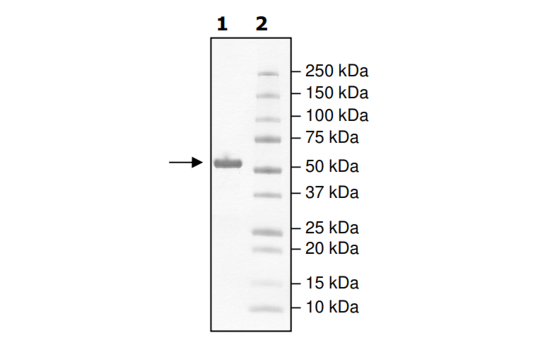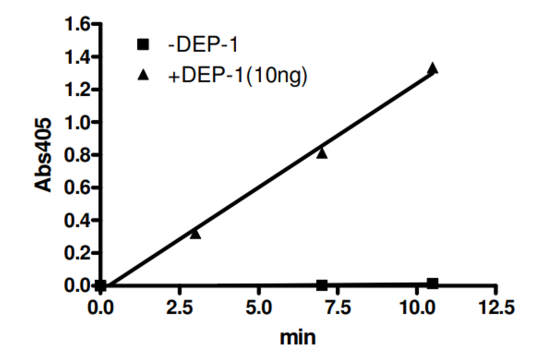DEP1(PTPRJ), GST-tag Recombinant
Catalog #
30050
$325
*
●
●
Purchase
Description
Protein tyrosine phosphatase DEP1 (density-enhanced phosphatase-1), also known as PTPRJ, PTP-eta and CD148 (GenBank accession no. NM_U10886), a.a. 1024-1306 (catalytic domain) with N-terminal GST-tag, MW=58.9 kDa, expressed in an E. coli expression system.
●
Synonyms
DEP1, density-enhanced phosphatase-1, PTP-eta, CD148, PTPRJ
●
Product Data Gallery
Product Info
Storage and Usage
Citations
Species
Human
Host Species/Expression System
E. coli
Purity
≥90%
Format
Aqueous buffer solution
Formulation
25 mM Tris-HCl, pH 8.0, 75 mM NaCl, 0.05% Tween-20, 50% glycerol, 2 mM EDTA, 1 mM DTT, 10 mM glutathione.
MW
58.9 kDa
Amino Acids
1024–1306
Specific Activity
268 nmole/min/µg
Genbank #
NM_002843
UniProt #
Q12913
Background
Tyrosine phosphatase which dephosphorylates or contributes to the dephosphorylation of CTNND1, FLT3, PDGFRB, MET, RET (variant MEN2A), KDR, LYN, SRC, MAPK1, MAPK3, EGFR, TJP1, OCLN, PIK3R1 and PIK3R2. Plays a role in cell adhesion, migration, proliferation and differentiation. Positive regulator of platelet activation and thrombosis. Positive regulator of endothelial cell survival, as well as of VEGF-induced SRC and AKT activation through KDR dephosphorylation. Negative regulator of cell proliferation. Negative regulator of PDGF-stimulated cell migration through dephosphorylation of PDGFR. Negative regulator of EGFR signaling pathway via EGFR dephosphorylation. Enhances the barrier function of epithelial junctions during reassembly. Negatively regulates T-cell receptor (TCR) signaling. Upon T-cell TCR activation, it is up-regulated and excluded from the immunological synapses, while upon T-cell-antigen presenting cells (APC) disengagement, it is no longer excluded and can
dephosphorylate PLCG1 and LAT to down-regulate prolongation of signaling.
References
1. A. Massa, et al., J Biol Chem. 2004, 279: 29004-12.
2. S. Kellie, et al., J Cell Sci. 2004, 117 :609-18.
2. S. Kellie, et al., J Cell Sci. 2004, 117 :609-18.



